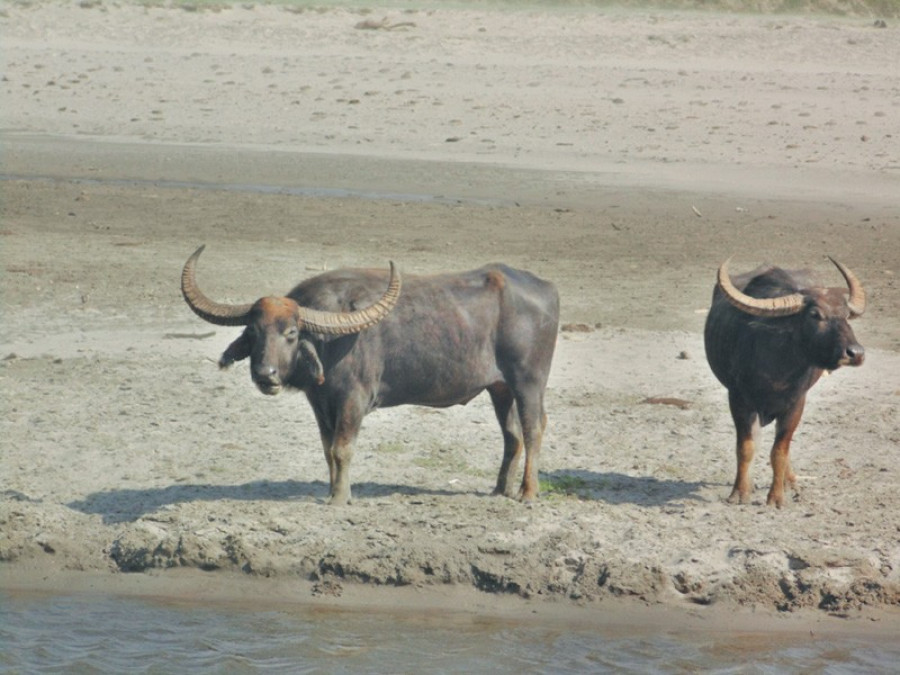Climate & Environment
Birth of calves gives hope to conservationists of increasing Arna population
Wild water buffaloes brought to Chitwan from Koshi Tappu Wildlife Reserve initially struggled to survive in their new habitat but they are slowly getting used to it.
Chandan Kumar Mandal
Birth of two calves of wild water buffalo, locally known as Arna, in Chitwan National Park, has elated park officials, giving them hope for its conservation in the new habitat.
Last month, a calf of Arna (Bubalus arnee) was born inside the Chitwan National Park. Another calf was born in Chitwan this week. Gender of both newborn calves has not been identified yet.
“Birth of two calves of Arnas within a month is exciting news from the conservation point of view,” said Ananath Baral, chief conservation officer at the Chitwan National Park.
“The arrival of two calves has also shown that the Chitwan National Park area can be an ideal habitat for Arnas. The park is turning out to be a suitable habitat for their birth and upbringing.”
Chitwan National Park, which is home to large animals like elephant, one-horned rhino and tigers among others, however, is not a native habitat for wild water buffaloes.
The government had decided to translocate 20 rhinos to Chitwan. As part of the translocation plan and for creating a new alternative habitat for Arnas, 15 wild water buffaloes were translocated from Koshi Tappu Wildlife Reserve and the Central Zoo in 2017.
However, many of the translocated Arnas could not survive in their new habitat. Five of them had died due to parasitic diseases and a tiger hunted one down.
“Initially, Arna conservation was met with challenges in Chitwan. Three brought from the Central Zoo could not survive the wilderness and others had died due to diseases and tiger attack,” said Baburam Lamichhane, who is the chief of the Biodiversity Conservation Centre, Sauraha, under the National Trust for Nature Conservation. “The remaining Arnas brought from Koshi Tappu have shown good signs of survival in their new habitat. They have also adapted better to their new habitats than other species which have been translocated within the country.”
The birth of a female Arna calf for the first time in Chitwan in 70 years in 2018 rekindled the hope of maintaining the Arna population in the protected area. In 2018, three calves were born, followed by one in 2019 and two this year.
According to Lamichhane, whose organisation has been involved in their translocation, monitoring and managing the reintroduced population, six calves from seven female adults is a notable sign of their growth.
These wild water buffaloes are currently living around the Old Padampur area, inside an enclosure built in a core area of the park.
The park authority has no plans of freeing these Arnas from enclosures and releasing them into the wild. Currently, the park’s 15 Arnas live in enclosures with areas of 22 hectares whereas the park has further expanded their habitat by 15 hectares.
“It depends on how they can survive once they are released. We also need to consider whether these species will be able to protect themselves from predators like tigers,” said Baral. “There is no immediate plan of letting them out as they are still in small groups.”
Lamichhane agrees with Baral, saying that the Chitwan park does not have a viable population for letting them out of the enclosure.
“The calves have survived because they are inside the enclosure. Once a tiger had breached the enclosure and attacked Arnas,” said Lamichhane. “The existing herd is not large enough to defend itself from tigers. It should be of around 50 individuals. With the current population, it will not be possible to release them out of the controlled enclosure.”
Arna is placed among endangered species—there are 3,400 of them in the world—on the International Union for Conservation of Nature Red List.
Until 2017, Koshi Tappu Wildlife Reserve remained the only natural habitat of wild water buffaloes in the country. The reserve has seen an impressive rebound of wild water buffalo population to 432 from a low of 63 in 1973. However, the conservation of these Arnas also faced challenges.
According to wildlife experts, close proximity of the reserve to human settlements creates chances of interspecies breeding between domesticated water buffaloes and indigenous wild water buffaloes, potentially threatening the latter. A mysterious death of cattle around the protected area last year worried officials about the possible transmission of the disease to the wild species.
“The number of Arnas has bounced back to 15—the number of Arnas that were brought to Chitwan three years ago. They are being taken care inside the enclosure and are given extra grass and supplements when there is malnutrition among them,” said Baral, the chief conservation officer. “Chitwan is an old habitat for these wild water buffaloes, but there is no such plan of bringing more animals as of now.”




 11.12°C Kathmandu
11.12°C Kathmandu








%20(1).jpg&w=300&height=200)

